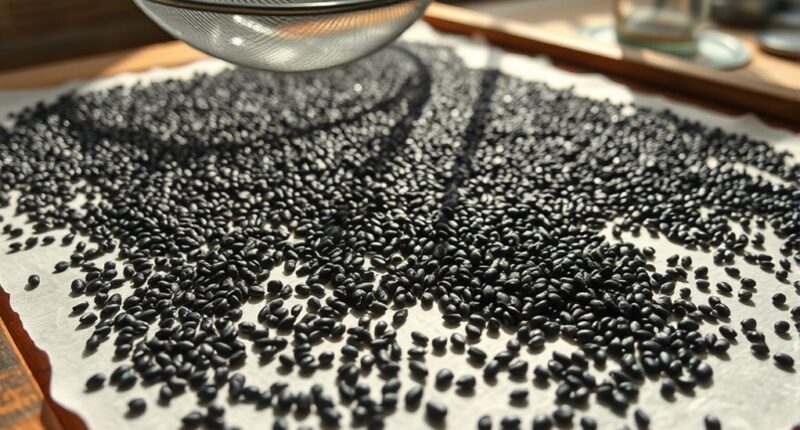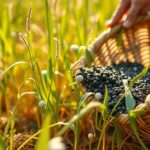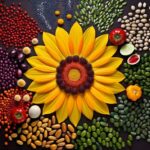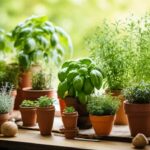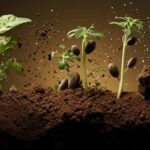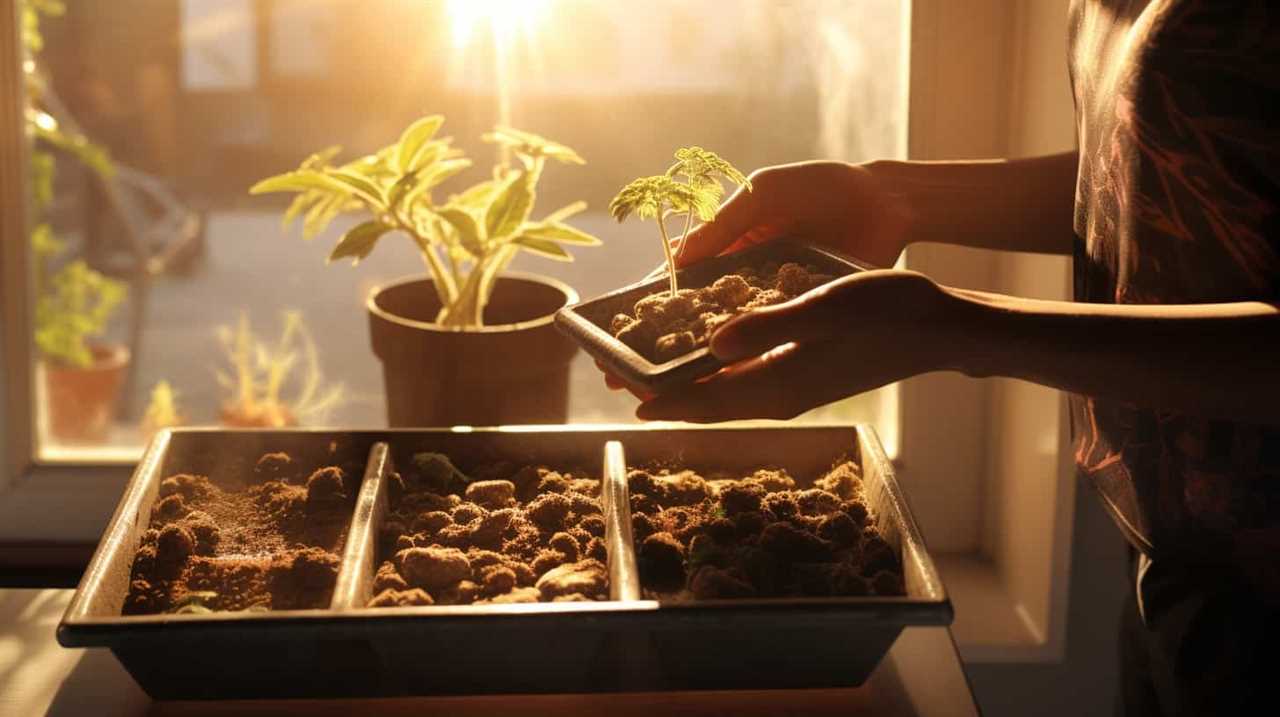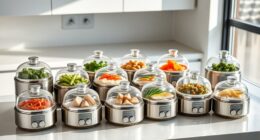After harvesting chia seeds, spread them in a thin layer on a clean tray or screen in a well-ventilated area away from direct sunlight. Stir or shake regularly to guarantee even drying, which may take hours to days depending on humidity. Once fully dry—seeds should rattle easily—you can clean debris using a sieve or by winnowing. Store the seeds in an airtight container in a cool, dark place to keep them fresh longer. Learn more about perfect drying and cleaning methods below.
Key Takeaways
- Spread harvested chia seeds evenly on a clean tray or screen in a well-ventilated area, avoiding direct sunlight.
- Stir or shake seeds regularly during drying to ensure even moisture loss.
- Allow seeds to dry completely, which may take several hours to days depending on humidity and temperature.
- Gently remove any debris, plant matter, or broken seeds using a fine sieve or by winnowing.
- Store fully dried and cleaned seeds in airtight containers in a cool, dark place to preserve freshness and nutritional value.
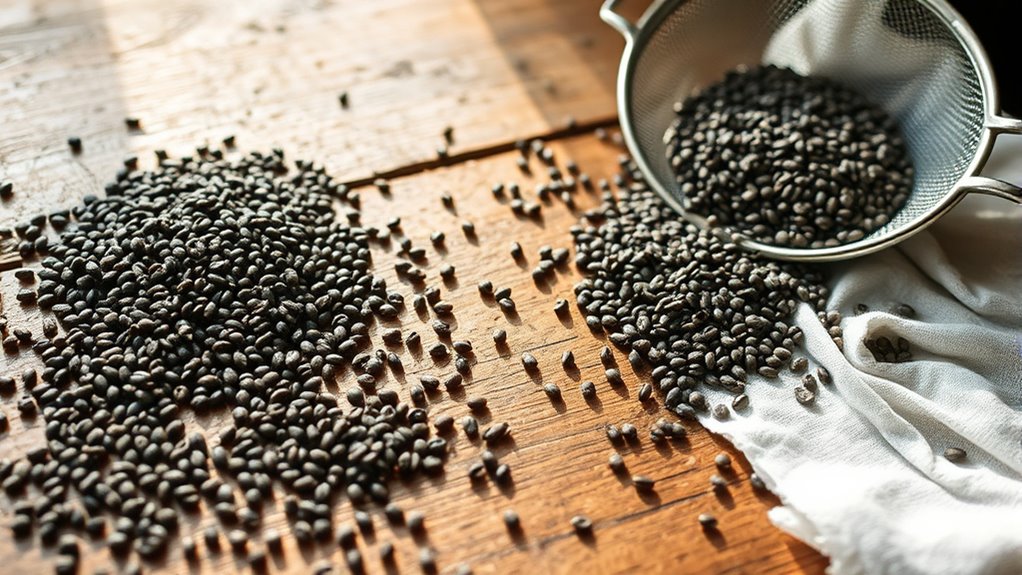
After harvesting chia seeds, proper drying and cleaning are essential to guarantee they stay fresh and safe to eat. Correct seed storage begins right after harvest, so it’s important to handle your chia seeds carefully to prevent spoilage or loss of quality. The first step is to contemplate your harvest timing; harvesting at the right moment ensures the seeds are mature and ready for processing. Usually, you’ll know they’re ripe when the flower heads turn brown and dry, and the seeds start to fall easily when shaken. Waiting too long can lead to over-mature seeds, which might lose their viability or become prone to mold, so timing your harvest accurately sets the foundation for successful seed storage.
Once you’ve harvested the chia seeds, the next step is to dry them thoroughly. Proper drying not only preserves the seeds but also makes cleaning easier. Spread the seeds out in a thin, even layer on a clean, dry surface such as a tray or screen. Place them in a well-ventilated area away from direct sunlight, as excessive heat can damage the seeds’ nutritional value. Stir or shake the seeds regularly to promote even drying and prevent mold growth. This process can take anywhere from a few hours to a couple of days, depending on humidity and temperature. Make sure the seeds are completely dry; any residual moisture can lead to mold or spoilage during storage.
Cleaning your chia seeds after drying is equally important. Carefully remove any debris, plant matter, or broken seeds that may have been mixed in during harvest. You can do this by winnowing—gently blowing away lighter chaff—or by passing the seeds through a fine sieve. Rinsing isn’t necessary unless you notice dirt or foreign particles, but if you do rinse, ensure the seeds are thoroughly dried afterward to prevent mold. Once cleaned and dried, store your chia seeds in airtight containers in a cool, dark place. Proper seed storage conditions help maintain freshness and extend shelf life, preserving their nutritional benefits for months.
Frequently Asked Questions
How Long Do Dried Chia Seeds Stay Fresh?
Dried chia seeds typically stay fresh for about 2 to 4 years if stored properly. To maximize seed preservation, keep them in an airtight container in a cool, dark place away from moisture and sunlight. Proper storage tips help prevent spoilage and maintain quality. Always check for any off smell or discoloration before use. With good storage habits, you can enjoy your chia seeds for a long time without losing their nutritional benefits.
Can Chia Seeds Be Stored Wet?
You shouldn’t store chia seeds wet because moisture control is key for seed storage. When seeds stay wet, they’re prone to mold and spoilage, which shortens their shelf life. Always guarantee your chia seeds are thoroughly dried before storage. Keep them in an airtight container in a cool, dry place. Proper moisture control helps maintain freshness, flavor, and nutritional value, ensuring you get the most out of your chia seeds.
What Are Common Signs of Spoiled Chia Seeds?
You should watch for spoilage indicators like a sour or off smell, mold growth, or a slimy texture in your chia seeds. If they develop discoloration or an unusual taste, they’re likely spoiled. Proper storage tips include keeping seeds airtight in a cool, dark place to prevent moisture and spoilage. Regularly check your seeds, and discard them if you notice any of these spoilage signs to ensure safety and freshness.
Is It Necessary to Sterilize Equipment During Cleaning?
Imagine your equipment as the gatekeeper to pure, healthy chia seeds. Yes, sterilization practices are essential; they act like a shield against bacteria and mold. When you clean, proper equipment maintenance is key—think of it as giving your tools a spa day to keep them in top shape. Skipping sterilization can invite spoilage, so always guarantee your tools are sanitized to protect your harvest’s quality and safety.
How Do Humidity Levels Affect Drying Efficiency?
Humidity impact greatly influences drying efficiency. If the humidity levels are high, moisture in the air slows down the drying process, making it less effective and prolonging the time needed to dry chia seeds thoroughly. To improve drying efficiency, you should aim for low humidity environments, which allow moisture to evaporate quickly. Proper airflow and controlled conditions help guarantee your chia seeds dry evenly and efficiently, regardless of ambient humidity.
Conclusion
Now that you know how to dry and clean your chia seeds, you’re well on your way to a bountiful harvest. Think of the process as nurturing a delicate garden—patience and care guarantee the best results. When you handle your seeds carefully, they’ll shine like tiny jewels ready to boost your health. With these simple steps, you’ll turn raw harvest into a treasure chest of nutritious goodness—your efforts truly pay off, like planting seeds for future wellness.
